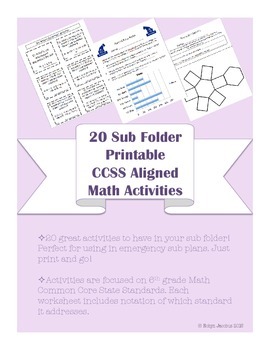6th grade 20 Math CCSS aligned worksheets & games for Sub Tub
- PDF
- Easel Activity
Description
20 great activities to have in your sub folder! Perfect for using in emergency sub plans. Just print and go! Also included is an Easel where students can complete the individual activities virtually/digitally!
Activities are focused on 6th grade Math Common Core State Standards. Each worksheet or game includes notation of which standard it addresses.
Also includes: a fact sheet for you to fill out about your class, a form substitutes can use to leave you notes for the day, and a sheet for you to fill out with information about any behavioral situations subs should be aware of.
A master sheet lists each activity and whether it is for individual work, partner work, small group work or whole class game.
CCSS Standards Addressed
Ratios and Proportional Relationships
6.RP.A.1- Understand the concept of a ratio and use ratio language to describe a ratio relationship between two quantities.
The Number System
6.NS.B.4- Find the greatest common factor of two whole numbers less than or equal to 100 and the lease common multiple of two whole numbers less than or equal to 12. Use the distributive property to express a sum of two whole numbers 1-100 with a common factor as a multiple of a sum of two whole numbers with no common fact.
6.NS.C.8- Solve real-world and mathematical problems by graphing points in all four quadrants of the coordinate plane. Include use of coordinates and absolute value to find distances between points with the same first coordinate or the same second coordinate.
6.NS.C.5 Understand that positive and negative numbers are used together to describe quantities having opposite directions or values (e.g., temperature above/below zero, elevation above/below sea level, credits/debits, positive/negative electric charge); use positive and negative numbers to represent quantities in real-world contexts, explaining the meaning of 0 in each situation.
Expressions and Equations
6.EE.A.4- Identify when two expressions are equivalent.
Geometry
6.G.A.3- Draw polygons in the coordinate plane given coordinates for the vertices. Use coordinates to find the length of a side joining points with the same first coordinate or the same second coordinate. Apply these techniques in the context of solving real-world and mathematical problems..
6.G.A.4- Represent three-dimensional figures using nets made up of rectangles and triangles, and use the nets to find the surface area of these figures. Apply these techniques in the context of solving real-world and mathematical problems.
Statistics and Probability
6.SP.B.5.C- Describe the nature of the attribute under investigation, including how it as measured and units of measurement.
6.SP.B.5.C- Giving quantitative measures of center (mean and/or median) and variability, as well as describing any overall pattern and any striking deviations from the overall pattern with reference to the context in which data were gathered.
You might also like the following 6th grade math CCSS aligned products:
6th Grade Math CCSS Story Problem Exit Tickets with Answer Keys
Dividing Decimals Maze Rescue the Sock Monkey
Decimal Operations Jeopardy PowerPoint Game
6th Grade Common Core Standard Math Vocabulary Exit Tickets and Word Wall






